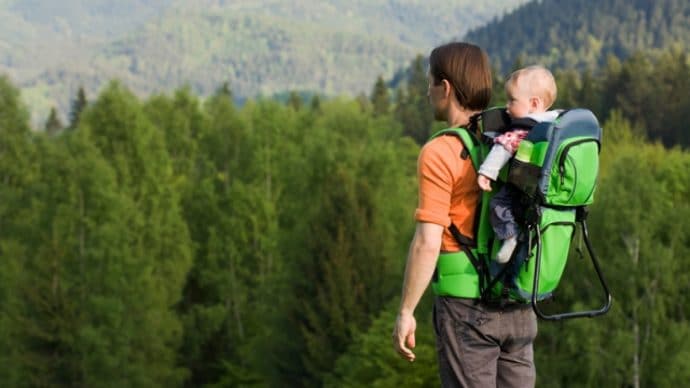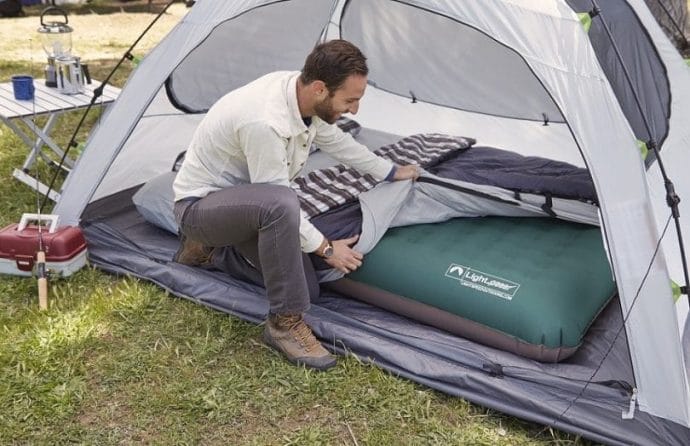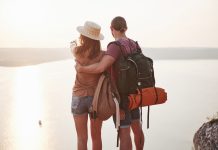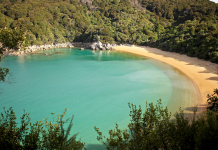Hiking is an amazing experience since it always has that amount of unpredictable. You’ll constantly be surprised by something, like a view, the weather or the difficulty of a certain route. But when you’re hiking with kids, the unpredictable factor reaches a whole new level and that’s why we’re here to help with our best tips and tricks, so you can have an unforgettable vacation.
Get an ergonomic carrier
This is first on our list because it’s valuable for experienced or inexperienced hikers alike, as well as for kids of different ages. An ergonomic carrier like a sling, a woven wrap or an SSC (structured soft carrier) will make your life a lot easier since you can’t bring a stroller.

image source: here
We recommend ergonomic carriers since these don’t force your baby’s spine in an unnatural position, and can be used successfully for older kids thanks to an efficient weight distribution on your shoulders and back.
If you’re new to hiking, you may venture off too far from camp or might get caught in a storm. That’s when such a carrier becomes essential, so you can walk faster. If you’re an experienced hiker, you might want to cover more ground, so you need to carry your kids to do that.
Plus, this is a much more efficient way than simply holding a newborn baby, eliminating the risk of tripping and falling. Your baby can even breastfeed while you’re hiking.
Even older kids, up to 5 or 6 years old might still get tired on the trail. And instead of picking them up or stopping too much, you can simply carry them.
Don’t change your sleep patterns
Your kids might adore a late night, especially when you’re outdoors. You can make a campfire, tell scary stories or cook marshmallows. But that’s not always such a good idea, especially for kids that haven’t reached their teens yet.

image source: here
That’s because a late night will mess with their sleep patterns. Kids that young need about 12 hours a sleep each night, or even more. So if you put them to sleep really late, they won’t be able to get up in the morning, or they’ll be cranky and agitated the next day.
An early evening is even better if you have a newborn. Sleep when the baby sleeps, right? Well, you need to make sure you’ve got all the comfort in the world to make that happen, so don’t forget bringing the best camping air mattress.
Such an air mattress is easy to pack and inflate, compact, light, and resistant to punctures. It will provide you the comfort you’re used to at home, so you can get enough rest.
Pack the essentials
The essentials mean different things for adults and for kids. Apart from your usual hiking gear, like a tent, sleeping bag, flashlight or multi-tool, you need to get what your kids view as primordial in their lives. That may mean their blanky or their teddy bear, and forgetting those might equal endless tantrums or sleepless nights.
What’s more, kids will get dirty fast when outdoors. They’ll be curious enough to jump into puddles or play in the dirt, so you need something to wash their clothes fast, seeing as you can’t carry the whole wardrobe with you. And that’s when a washing bag comes into play, seeing as it can use different sorts of sweet or salty water, it’s light and compact.
Structure the fun
Although you’re bringing their favorite teddy, you can also bring specifically designed toys for camping. For instance, a playpen will make your life a lot easier when you’re cooking a meal and want to keep an eye on your kids so they don’t wander off.
Another good piece of gear is a children’s tent. Some of these tents have a high UV protection factor, they’re perfectly ventilated and offer cozy mattresses. Your children can play or sleep there, and they’ll feel like grown-ups with their own tents.
However, make sure you provide plenty of opportunities for your kids to explore nature. Long walks, building a shelter from fallen branches or gathering leaves will improve their knowledge and will make them love nature.
Stay safe
Make sure you’re always hydrated. When they’re having plenty of fun, kids forget about themselves, so they might even ignore thirst. So you need to offer them water at regular intervals, and make sure they drink enough throughout the day.
And if you run out of potable water because you haven’t packed enough, you can always benefit from a few water purification tablets. These have the advantage of portability, and they’ll clean out any water source, getting rid of almost all waterborne bacteria and parasites.
Another important piece of gear that will help you stay safe is the First Aid Kit. Even if you’re just going on a backcountry hike, and you wouldn’t normally bring one if it were just you.
The truth is that kids tend to get scrapes and bruises all the time because they’re less careful than adults. So you need at least a few bandages and an antiseptic lotion to clean potential wounds.
An insect repellent that’s safe for children of all ages is also a must, seeing as kids are more prone to insect bites. We also recommend a sunscreen with a high UPF factor to make sure your kids don’t get sunburns, considering their skin is much more sensitive.
The best advice
All that being said, our best advice is: don’t forget to have fun. Don’t treat your kids very differently just because they’re younger than you. They want and need their fun, and they’re capable of understanding a lot of things. So when they’re all grown up they’ll show the same love for the great outdoors they see when they’re young.
If you’ve hiked with your kids before, you can drop us a line. Tell us which tips worked for you, or share your mistakes. The comment section is just a scroll away.














